Family : Pomacanthidae

Text © Giuseppe Mazza

English translation by Mario Beltramini
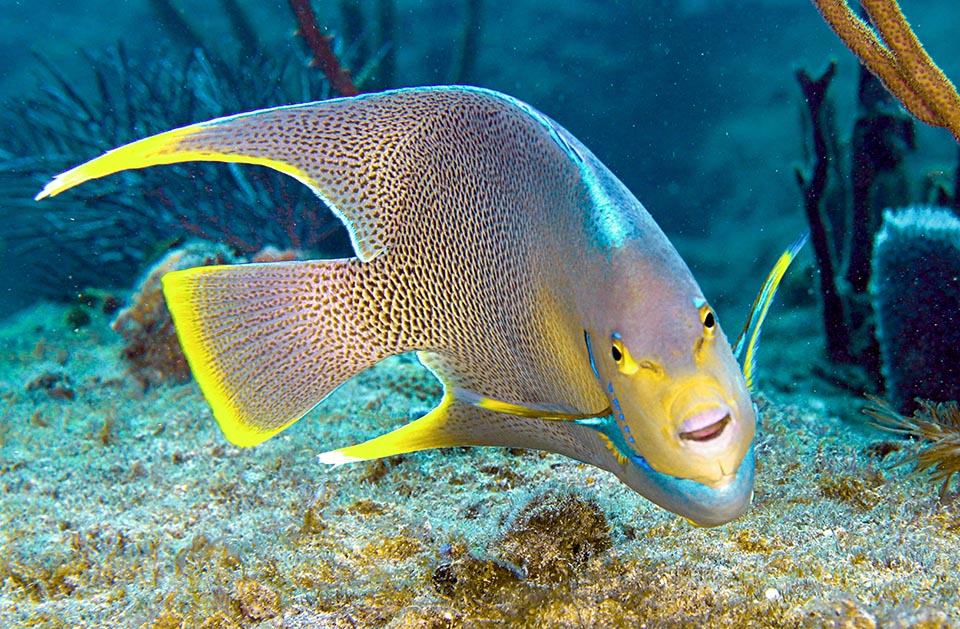
Holacanthus bermudensis lives in the western Atlantic tropical waters, mainly between the Gulf of Mexico and the Caribbean Sea © Kevin Bryant
The Blue angelfish (Holacanthus bermudensis Goode, 1876), belongs to the class of Osteichthyes, the bony fishes, to the Actinopterygii, the ray-finned fishes, to the order of Perciformes and to the colorful family of Pomacanthidae, the angelfishes, that count 8 genera and 91 species present also in brackish waters.
The etymology of the genus Holacanthus comes from the Greek “olos” = entire, whole and “akantha” = spine, to evidence the great spine on the preoperculum and the presence of interopercular spines. In short, it is a totally spiny fish.
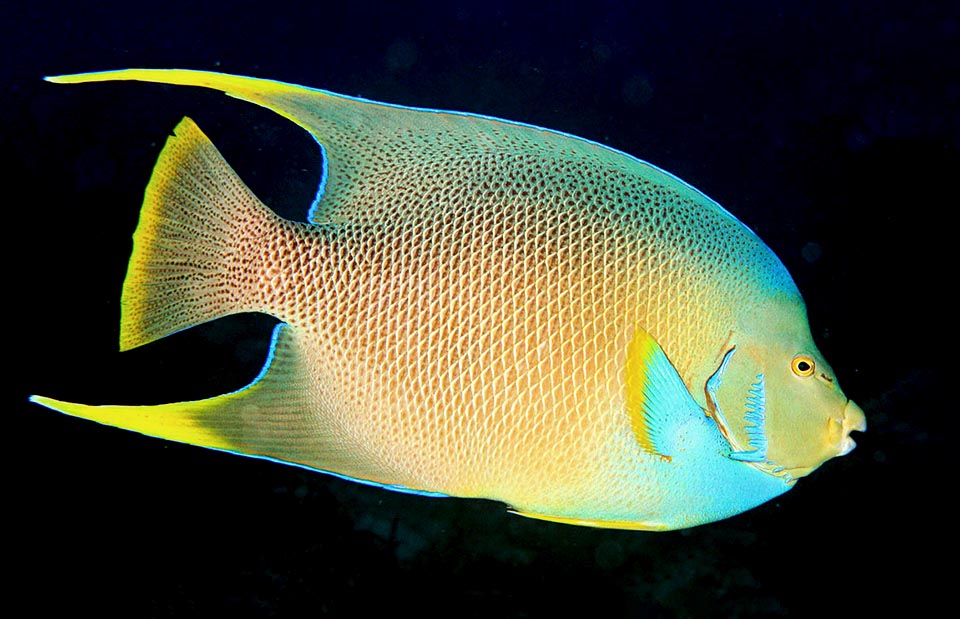
Even 45 cm long, it’s the biggest angelfish. It is found in the lagoons, among corals, but also on the outer border of the reefs up to 90 m of depth © Kevin Bryant
The specific name bermudensis, comes from the Latin and means “from Bermuda”, in reference to the presence of this species along the coast of this islands and to the fact that one of the syntypes (individuals used by the author to describe the species) was collected by Goode in this islands.
Zoogeography
It is present in the tropical waters of western Atlantic. We find it at the Bermudas, in southern USA, in Mexico, Belize, Honduras, Nicaragua and Cuba.
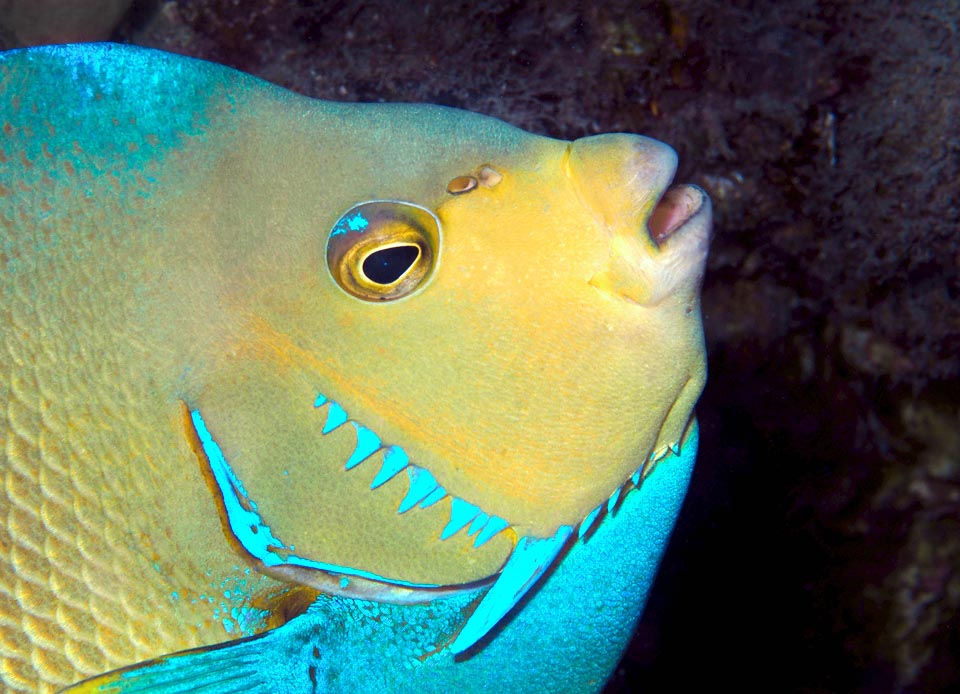
As the generic name Holacanthus states, in Greek “all spiny”, it is characterized by a showy spine on the preoperculum to which add other interopercular spines © Pauline Walsh Jacobson
In fact, it lives mainly between the Gulf of Mexico and the Caribbean Sea.
Ecology-Habitat
It is found in the lagoons, among corals, but also along the rocky cliffs and amidst the currents on the outer border of the reefs where it can go down up to 90 m of depth.
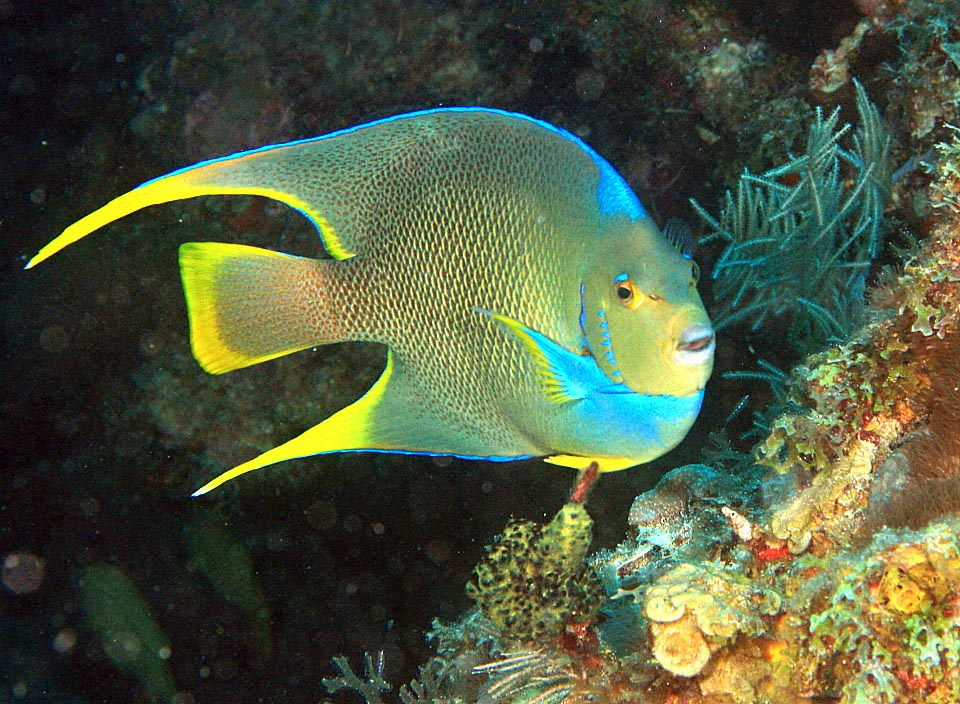
The livery shows some yellow and some blue, but greenish light blue is clearly dominant with pastel blue shades © Kevin Bryant
Morpho-physiology
Like the Holacanthus ciliaris, to which anatomically it resembles a lot, it reaches the length of 45 cm and the weight of 3 kg.
The body is flat, almost oval, and also here, in the old specimens, the dorsal and the anal fins prolong well beyond the tail. Also here, the livery foresees some yellow and some blue, but the greenish light blue is markedly predominant with shades of pastel blue, hence the English name, unequivocally, of “Blue angelfish” and the French one of “Demoiselle bleue”.
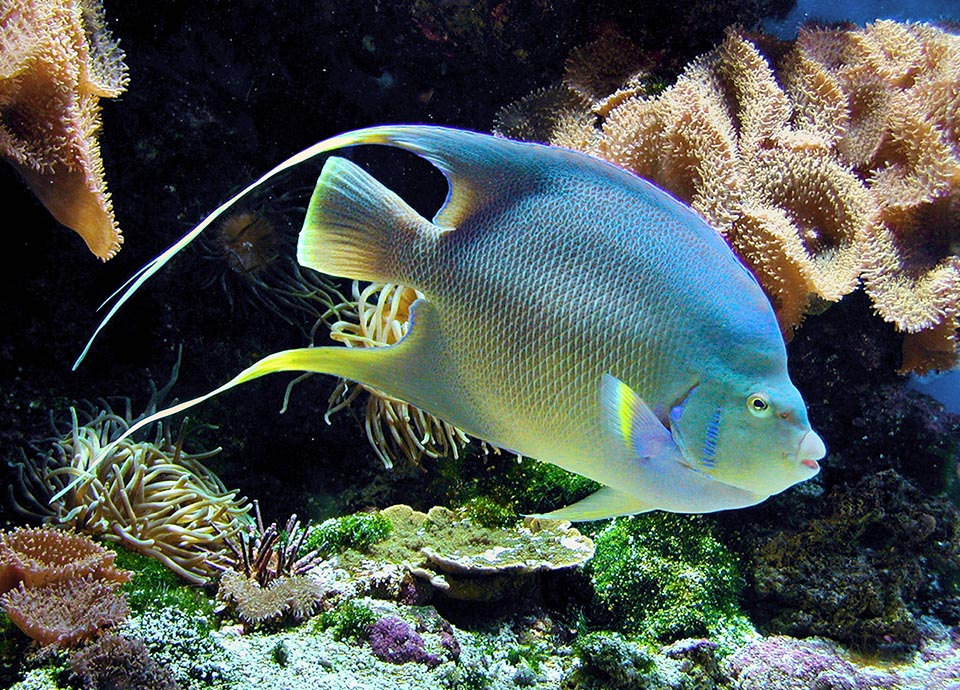
In the old individuals the dorsal and the anal fins may even prolong on the sides excessively. It is a specie eating hydroids, bryozoans, jellyfish, ascidians, sponges, weeds or aquatic plants, and even if it is often consumed by the Caribbean fishermen, the flesh, depending on its diet, is at ciguatera risk, a serious food poisoning © Giuseppe Mazza
To note the yellow band on the pectoral fins on the border of the tail and on the prolongation of the dorsal and anal fins and a characteristic vertical alignment of blue strokes on the operculum.
Also the juveniles’ livery, completely different from the adults’ one, is very similar to that of the Holacanthus ciliaris : both species, in fact, present some clear lines which here are slightly more vertical. Seen the huge number of spawned eggs and the home range largely overlapped, there is also who speaks of hybridization between the two species.
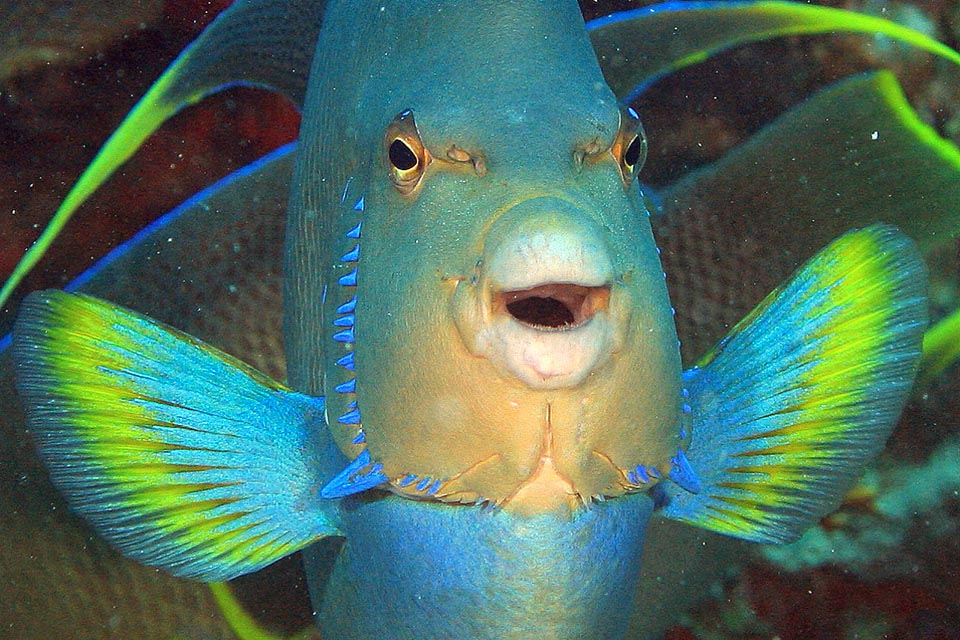
Holacanthus bermudensis is a solitary species, but this seems elated, displaying outstretched pectorals with the typical yellow band, because it has just sighted a female © Kevin Bryant
Ethology-Reproductive Biology
The Holacanthus bermudensis nourishes of various benthic animals, such as hydroids, bryozoa, jellyfishes, ascidians and especially of sponges, but also of seaweeds and aquatic plants.
It is a rather solitary territorial species, if we exclude the mating season. It can reproduce all the year round. The eggs, pelagic and floating, are fecundated in open seas.
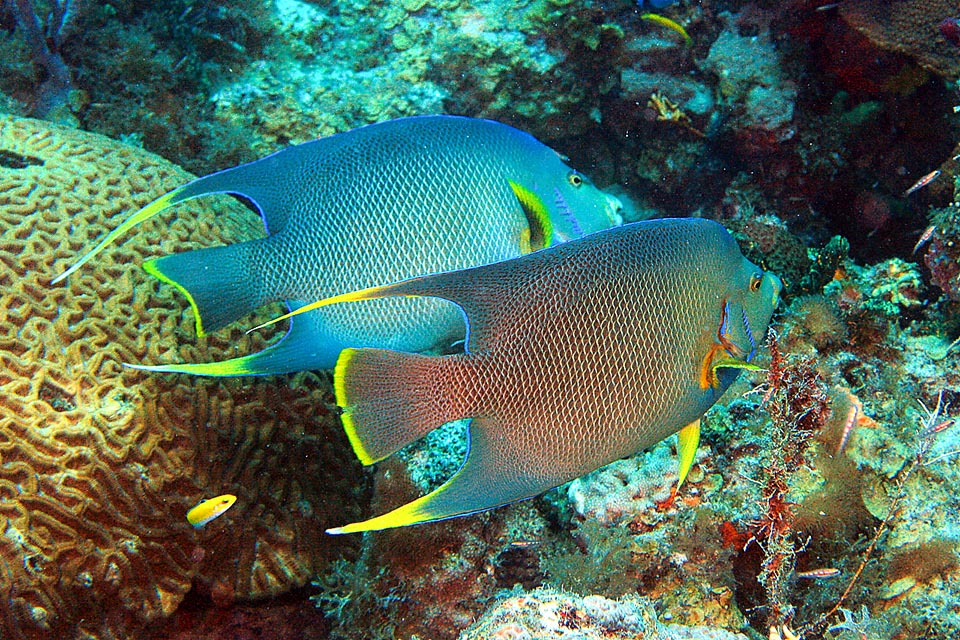
It can reproduce all year round. The eggs, pelagic and floating, are fecundated in open seas and a female may release even 75.000 of them per day © Kevin Bryant
The females may release even 75.000 of them per day and hatch immediately, nourishing, for a couple of days, of the yolk sac.
Then, they greedily nourish of plankton and grow up visibly. The juveniles often behave, like the Labroides, as cleaning fishes, taking off the parasites from various species, turtles included.
It can adapt to the aquarium life, but it is to be kept in appropriate pools without conspecifics because it would immediately enter in conflict with them. If well nourished, it can live even twenty years.
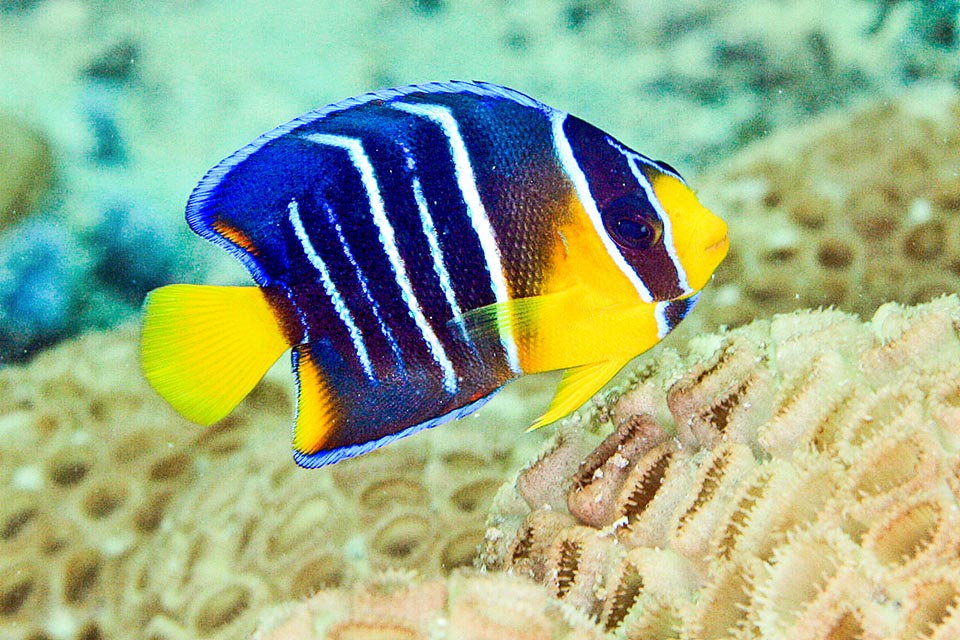
A young specimen. Growth is fast and initially, like the cleaning labrids, they free the big fishes and the turtles from the skin parasites © Kevin Bryant
Seen the size, it is at times consumed by the fishermen of the Caribbean, ignoring the risk of ciguatera, a serious alimentary intoxication related to the presence of poisonous organisms in its diet.
In nature the populations may double in 1,4-4,4 years and despite a certain fishing vulnerability the species appears nowadays as “Least Concern”, that is not endangered, in the IUCN Red List.
Synonyms
Holacanthus ciliaris bermudensis Goode, 1876; Angelichthys isabelita Jordan & Rutter, 1898; Holacanthus isabelita Jordan & Rutter, 1898.
→ For general information about FISH please click here.
→ For general information about BONY FISH please click here
→ For general information about CARTILAGINOUS FISH please click here.
→ To appreciate the BIODIVERSITY of BONY FISH please click here.
→ To appreciate the BIODIVERSITY of CARTILAGINOUS FISH please click here.
